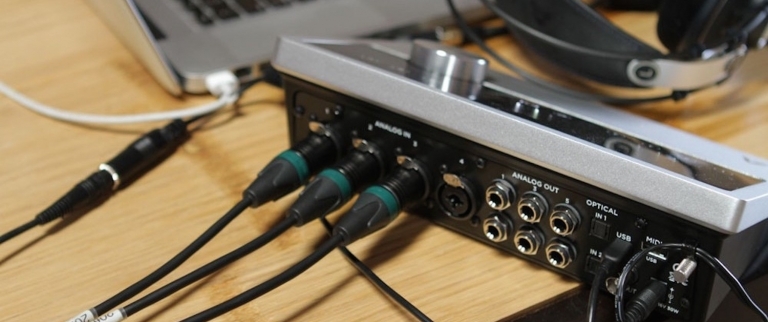
So you’ve decided you need a new interface and you’ve been scouring the internet reading reviews and tips on picking out the perfect fit. You might have even read our blog post, 5 Things You Need To Know When Upgrading Your Audio Interface. Let’s review the questions you should be asking in order to find out exactly what you’re looking for.

What sort of connectivity ports does your recording system have? USB, FireWire, Thunderbolt? Do you want to be able to connect to an iOS device? With technology evolving everyday, new improvements to connectivity and compatibility have flooded the market. If you record large sessions requiring significant I/O and need a lot of bandwidth, Thunderbolt may be the best option for you. You can move data to and from your interface up to 25 times faster than FireWire.
However, you don’t need more power than you’ll ever use. If you’re typically only recording vocals or a few guitars here and there, Thunderbolt could be overkill and USB 2.0 provides more than enough bandwidth to accommodate your needs. USB 2.0 offers even lower latency than FireWire – though not quite as low as Thunderbolt, you might find it to be perfectly fine in the majority of recording scenarios.
Before you rush out and buy a Thunderbolt interface, take a look to make sure your computer has a Thunderbolt connection available. The last thing you want to have happen is buy an interface on specs alone and realize you can’t run it with your system.
Make sure your operating system is up to date with the latest version. Many new interfaces on the market require certain OS specifications in order to run. If you are insistent on utilizing an older OS version, just make sure the interface you’re considering is compatible. Are you recording on a Mac? A PC? This is also very important to remember when shopping since some interfaces are designed specifically for certain platforms.

Are you recording multiple instruments at a time? Do you track drums pretty often with multiple mic inputs? Knowing how many inputs you typically need will help you when deciding what kind of interface you’re looking for.
If you’re mainly using it to track one or two things at a time, the Duet is a perfect option that offers incredible performance. There’s no need to buy more than you need. If you’re doing minor home recording, you probably don’t need 8 different inputs.
One thing to think about is what you NEED vs what you WANT. Many people think they need 8+ inputs to record drums, but often they are using sub-par gear and getting lower quality result than had they put up a couple good mics through a great interface. Check out this video we did about recording drums with 2 and 4 microphones – its proof that sometimes less can be more, so long as the gear you’re using is of a high quality.
Consider your typical recording session when deciding how many inputs and outputs you need out of your new interface.

Using multiple monitors when mixing can be incredibly handy when listening for certain aspects of a song. Rather than have a separate monitor control, certain interfaces like the Quartet offer a built-in monitor control in the interface itself.
This isn’t a necessity, but if you’re looking to consolidate and save some space, it’s a great feature to look for. Not to mention you’ll look like a professional when seamlessly switching monitors easily through your interface’s nifty touch pads.

This question is pretty basic—what are you typically recording? Are you recording hip hop vocals or an orchestra? This goes along with the “how many inputs” question listed above. Your primary use of your interface will determine what kind of power you’re looking for.
As said above, think about your average session. What do you find yourself needing often? Interfaces like the Ensemble offer features like talkback and dual mode re-amp outputs. Along with more inputs, some high-end interfaces offer extremely low latency and special features like input selection buttons and being able to connect up to 4 units.

Sometimes it comes down to something as simple as how much you’re willing to spend. If you have a budget of under $1000, you can still find some pretty solid interfaces, but could be forgoing the total I/O, sound quality or features of other more expensive interfaces.
That’s not to say you can’t record great songs through these interfaces. The Duet is a great high-end interface for under $1000 that allows you to record with the highest quality. Don’t fall for all the bells and whistles you see on other interfaces. For example, If you’re getting all the same Apogee Ensemble features and I/O on an alternative interface for $800, you probably won’t be getting the same quality.
Music is your craft, your passion and your profession—invest in your love. Don’t cheapen yourself by buying a low-quality interface. Start off with what you can afford and build up from there.
For those who have a higher budget and are looking to really level up their studio, the new Symphony I/O MkII will take you there. You can dazzle your clients with the touchscreen and unbeatable AD/DA conversion!
This new blog is presented by the team at Sound Technology Ltd, a leading distributor of musical instruments and pro audio equipment in the UK and ROI.